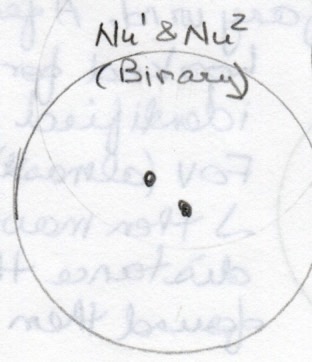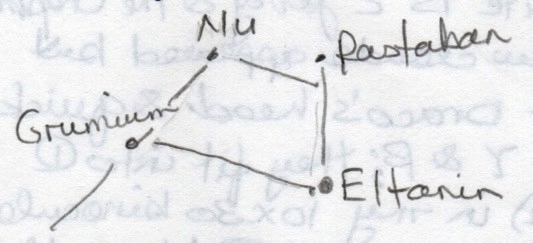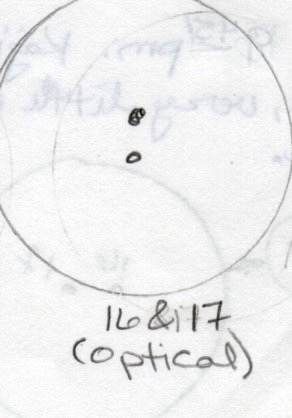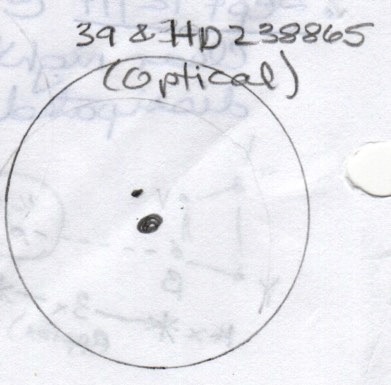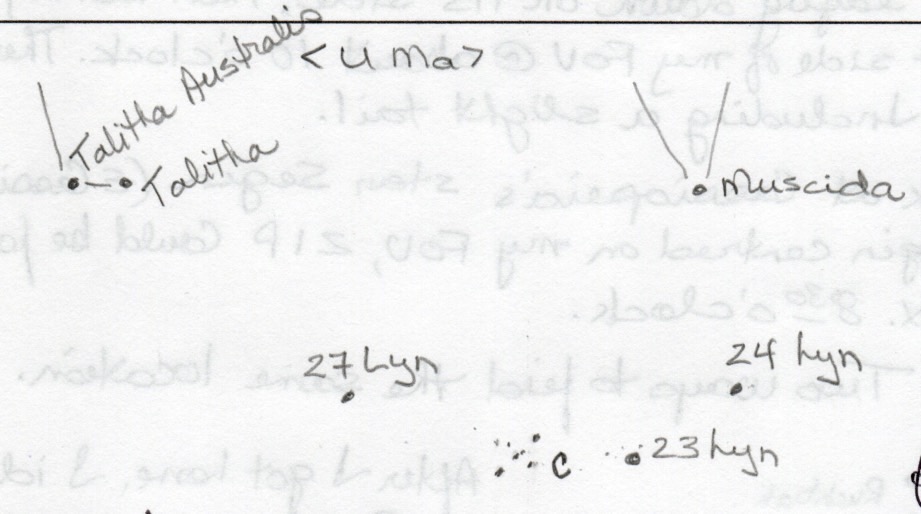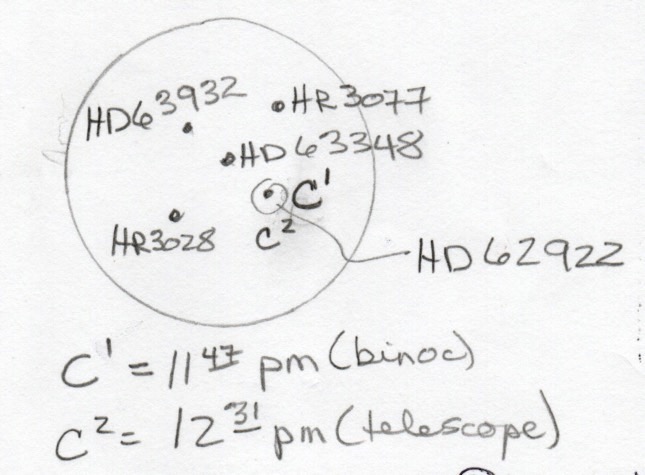|
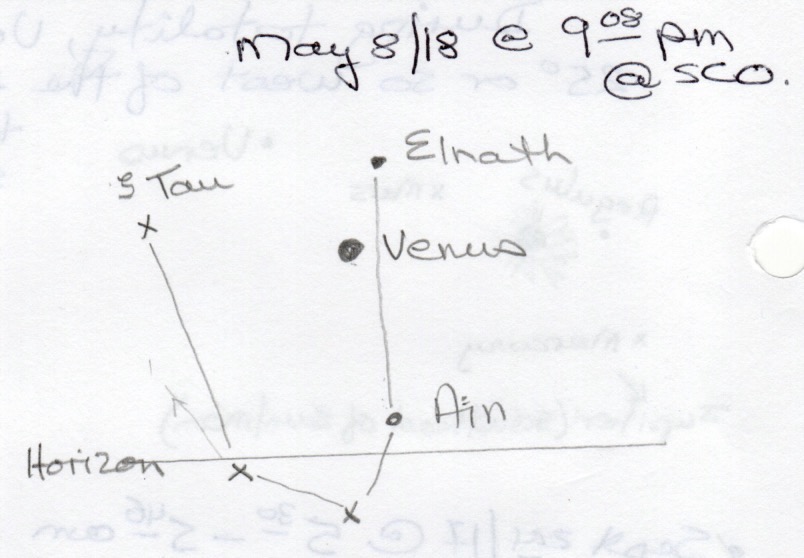
|
Venus (in Taurus)
Time: 9:08 PM ADT
Instrument: Visual
Went out to the road to get away from the trees. Venus appeared to have moved to the left of the line between Elnath and Ain and also lower in the sky, or so it seemed. While looking for ζ Tau, I came across a very red star - Betelgeuse! |
|
Jupiter (in Libra)
Time: 9:15 PM + 12:15 AM ADT
Instrument: Visual + Binoculars
Jupiter was in opposition.
Visual: @ 9:15 PM - Saw Jupiter half way up the trees but could not make out Libra.
Binoculars: @ 12:15 AM - Tried earlier to see Libra earlier in the evening but haze prevented it. Finally saw α, β and σ with Jupiter somewhere in the line between α and β and not just towards α.
|
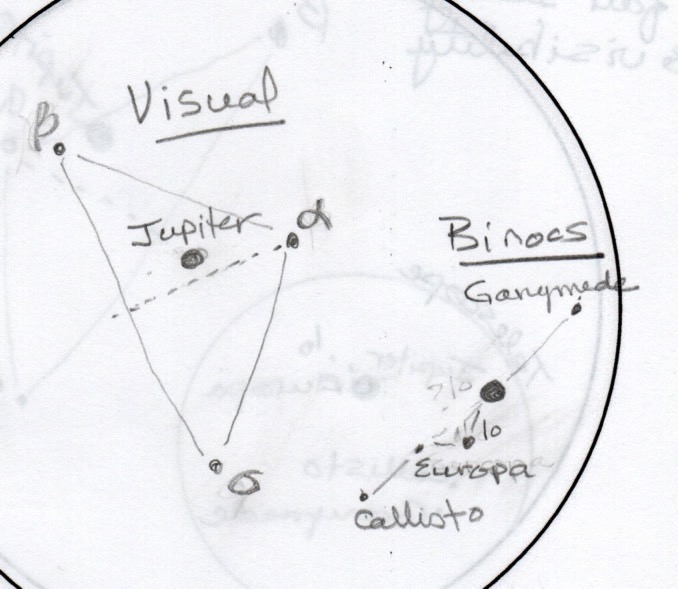 |
|
Winter Circle
Time: 9:18 PM ADT
Instrument: Visual
Had gone out to the road to locate Aldebaran and Tau θ1 and θ2 - not! Too low in the sky. However, I did see other stars of the Winter Circle that is slowly sinking below the horizon in the west - Procyon, Pollux, Castor, and Capella.
A happy coincidence was that while searching visually and with binoculars, I saw a bright red star at the same level as ζ Tau but much further south - Betelgeuse!
|
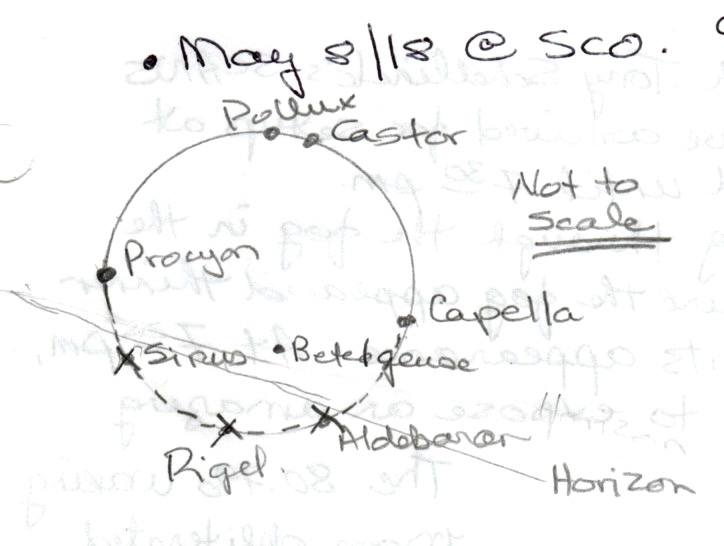 |
|
Cancer, M44/Beehive Cluster/Praesepe, & M67
Time: 9:18 PM ADT
Instrument: Visual + Binoculars + Telescope
S&T Chart Reference: 65
Caught this constellation next to Leo and above Hydra. All the stars were very faint so it took a while to locate them.
I actually found M44 while searching in that area for α Serpens. Noticed it visually then used the binoculars. After that, I took some time to locate the faint stars of this constellation, i.e., faint relative to other stars adjacent to it. I viewed the two Messier Objects visually, with my binoculars and then Jerry located them with our 10" Meade SCT.
M44 / Beehive Cluster / Praesepe
Time: 10:10 PM ADT
Instrument: Visual + Binoculars
S&T Chart Reference: 24
Refer to the entry for this in Messier Catalogue - M044 (beehive Cluster / Praesepe) - May 8/9, 2018.
M67
Time: 10:10 PM ADT
Instrument: Visual + Binoculars
S&T Chart Reference: 24
Refer to the entry for this in Messier Catalogue - M067 (NGC 2682) - May 8, 2018.
|
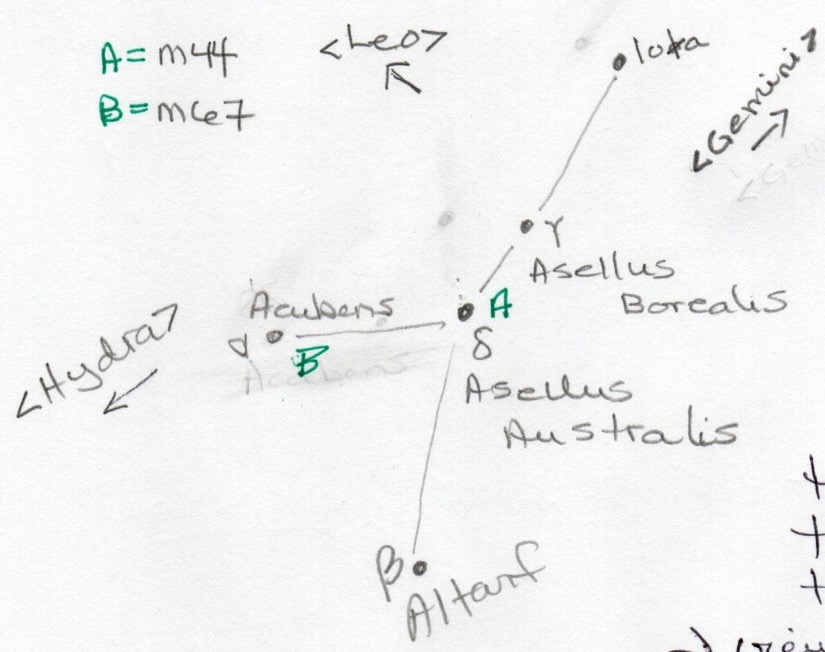 |
|
Ursa Major (UMa)
Time: 9:26 PM + 11:47 PM ADT
Instrument: Visual
S&T Chart Reference: 31, 32, 33, 43, F
All the stars of the the Big Dipper were easily located and identified. At 11:47 PM, while searching for the comet, I identified stars in UMa that I had not done before - Talitha, Talitha Australis and Muscida. These were used as the start point to star hop to 27 Lynx and CH Lynx to find the comet. The sketch shows the orientation of the constellation for this session. Three stars were almost parallel to the horizon - κ, ι and ο.
|
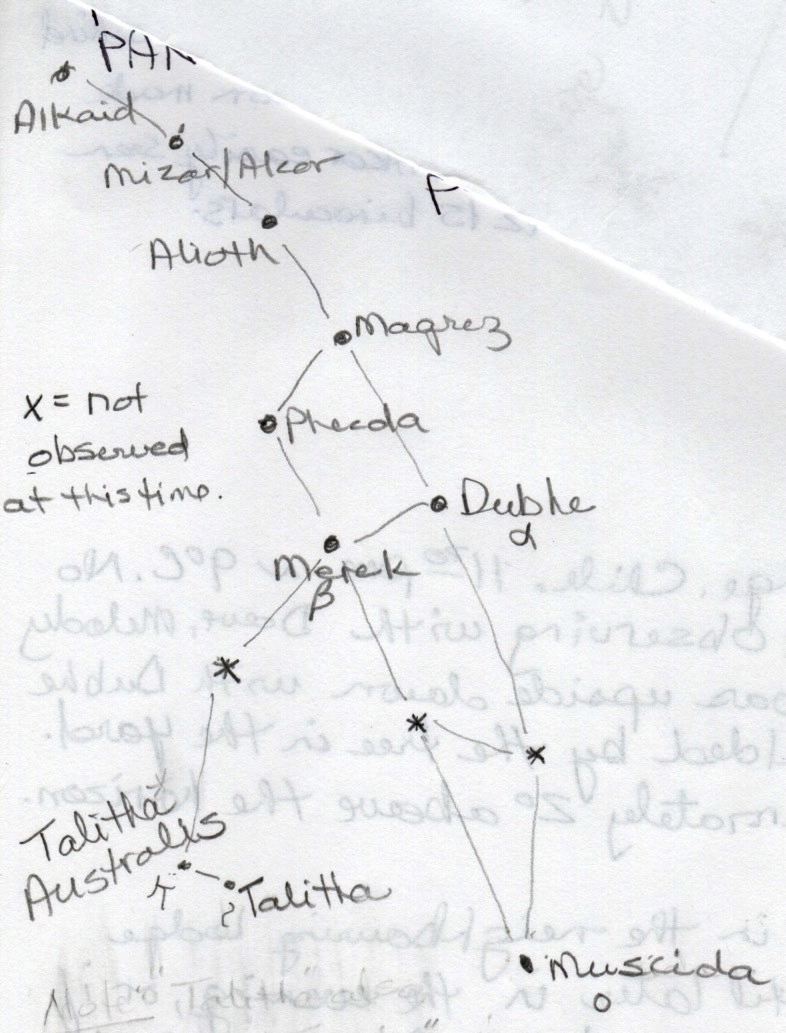 |
|
Corvus (Crow)
Time: 9:32 PM ADT
Instrument: Visual
S&T Chart Reference: 47
Corvus was first observed at this time. The 5 stars were readily seen. They disappeared / became very faint for a wile in the haze but then became visible again around 1 AM.
|
Leo
Time: 9:32 PM ADT
Instrument: Visual
S&T Chart Reference: 34, 35
Only Denebola, Zosma and especially Regulus gave Leo's location away. By 10:00 PM and for the remainder of the session, the remaining stars of the constellation (Chertan and those of the Sickle) came into view. Could follow Leo's path through the night sky. |
|
M53 / NGC 5024
Time: 10:37 PM ADT
Instrument: Telescope
S&T Chart Reference: 45
Refer to the entry for this Messier object in Messier Catalogue - M053 (NGC 5024) - May 8, 2018.
|
|
M81 / NGC 3031 / Bode's Galaxy
Time: 1:43 AM ADT
Instrument: Telescope
S&T Chart Reference: 45
Refer to the entry for this Messier object in Messier Catalogue - M081 (NGC 3031 / Bode's Galaxy) - May 8, 2018.
|
M82 / NGC 3034 / Cigar Galaxy
Time: 10:15 PM ADT
Instrument: Telescope
S&T Chart Reference: 31
Refer to the entry for this Messier object for how this object was found and its description and sketch - Messier Catalogue - M082(Cigar Galaxy, NGC 3034) - May 8, 2018.
|
|
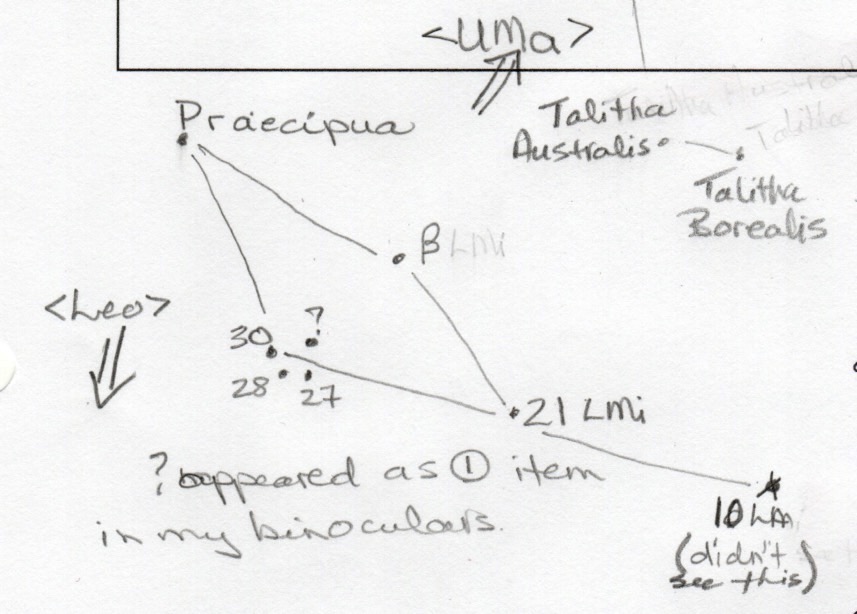
|
Leo Minor
Time: 10:52 PM ADT
Instrument: Visual + Binoculars
S&T Chart Reference: 33, 34, 35
Given Leo was relatively high in the sky, I decided to try for Leo Minor.
I used Adhafera and Rasalas as a base for the search. Looked halfway along that line then moved my eyes upwards a bit before putting up my binoculars. Imagine my surprise when I saw 4 stars in a tight cluster in a rectangular formation. Using SkySafariPro, I identified them as 27 LMi, 28 LMi, 30 LMi with the fourth star perhaps having two components - UU LMi and HD90024 - that appeared as one entity in my binoculars.
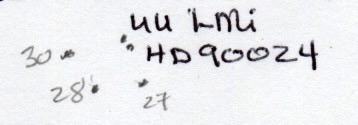
|
|
Draco
Time: 11:17 PM - 11:30 PM ADT
Instrument: Visual + Binoculars
S&T Chart Reference: 41, 42, 51, 52, 61
I have an article from Sky&Telescope (S&T) abut the 16 star doubles in this constellation so decided to get a start on locating them.
Could make out the general shape of the constellation then set to work to find three pairs - binary double (ν1 & ν2) and two optical doubles (16 & 17, and 39 & HD238865).
Guess the others will come later.
|
|
|
Comet: C/2016 N6 (PANSTARRS)
Time: 11:47 PM ADT
Instrument: Visual + Binoculars + Telescope
S&T Chart Reference: 22
I didn't identify all the stars of Lynx, only those relating the position of this comet.
Telescope:
Jerry found it with the telescope first. Knowing the star formation adjacent to comet C/2016 N6, we then looked at SkySafariPro to find the stars then begin the star hopping.
Visually:
1- Talitha and Talitha Australis of Ursa Major (UMa) were on a parallel line with Muscida. We used these as the top reference stars.
2- Below UMa were 2 stars of Lynx that also appeared parallel - 27 Lynx and 24 Lynx.
Binoculars:
At approximately 7 o'clock to 24 Lynx is 23 Lynx. I put my binoculars up to that general area and to may pure joy it was there! The dull grey fuzzy to the right of a star looked like it did in the Meade SCT! Could even see the 5 stars adjacent to it that made it so quick to recognize as the correct location. At 11:47 PM, the comet was 3 o'clock to HD62922 but one hour later was at 6 o'clock.
|
|
|
Serpens Caput
Time: 12:15 AM ADT
Instrument: Visual
S&T Chart Reference: 55
This was one of my target constellations for this session. It is located 'below' Corona Borealis and next to Ophiuchus. Amazing that I could see these stars. It took a few seconds to recognize the 3 stars of its head and some of the body stars, but I did see them. I was excited to add another constellation to my list! Also interesting that it terminates in Ophiuchus (unless you prefer that Serpens Caput, the base of Ophiuchus and Serpens Cauda combine into one - Serpens).
|
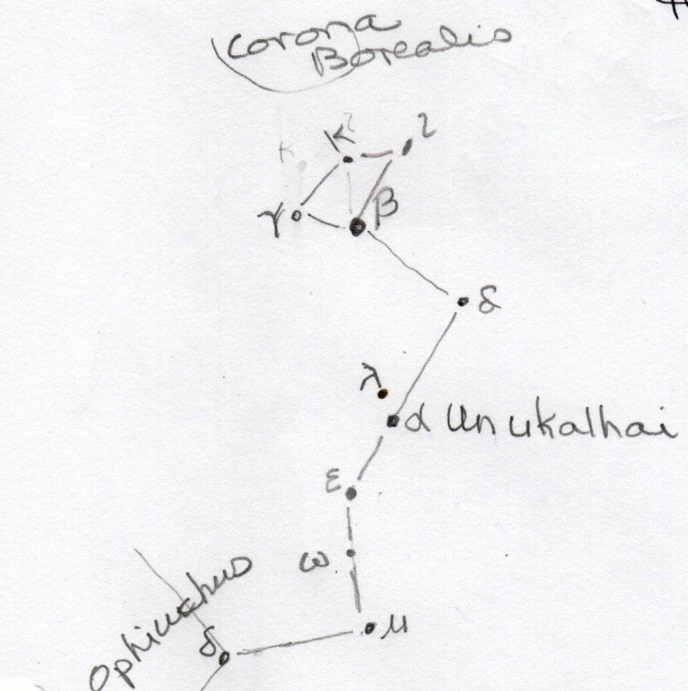 |
|
Corona Borealis
Time: 12:53 AM ADT
Instrument: Visual
S&T Chart Reference: 53, 55
The wind had died down but it was still cold enough to require my winter coat, hat and mitts. I identified the stars of Corona Borealis as a way of locating Serpens Caput below it.
|
Crater (Cup)
Time: 12:53 AM ADT
Instrument: Visual
S&T Chart Reference: 36
Visibility and seeing below 10º on the horizon is non-existent due to haze or fog or clouds. I could see the base of Crater earlier in the evening but the cup stars were elusive. |








